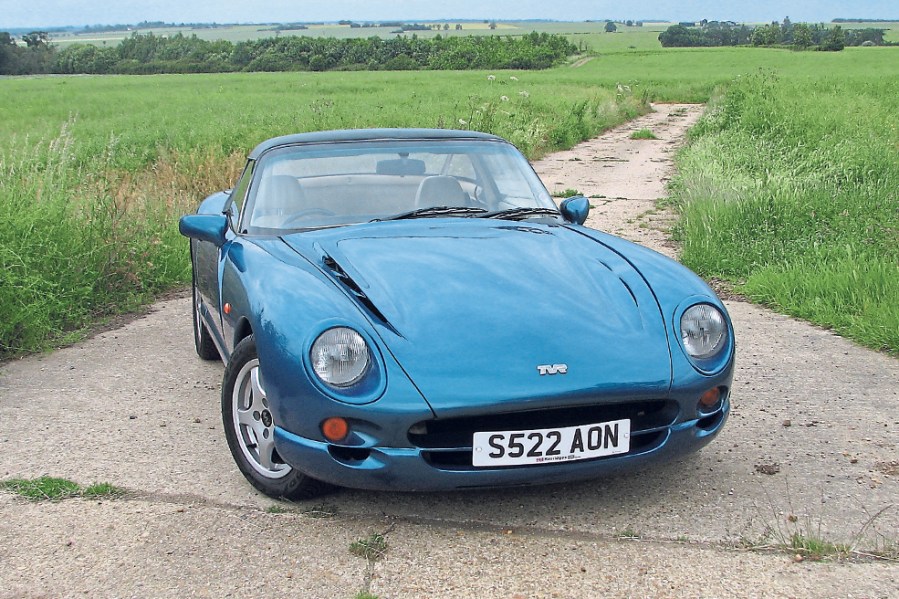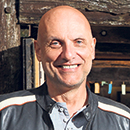If most modern-classic sports cars are too mainstream for your tastes, you might be tempted by the TVR Chimaera. Here’s how to buy a great one today
Sponsored editorial in association with Lancaster Insurance
Mention you’re thinking of buying a TVR down at the pub and you’ll likely be met with raised eyebrows, a grin, and then the inevitable: “But what about the build quality?” It’s true that TVR’s reputation for reliability was patchy – some might say it lasted decades – though that’s rather unfair. By the time the Chimaera launched in 1992, standards had come on leaps and bounds. Based on the Griffith, it was conceived as the most practical and user-friendly TVR to date.
Despite this softer brief, the Chimaera didn’t sacrifice pace. Between 1992 and 2003, it was offered with 4.0-, 4.3-, 4.5- and 5.0-litre Rover V8s, producing 240-340bhp and, from 1994, mated to Borg Warner’s robust T5 gearbox. Even the ‘entry-level’ 4.0-litre was blisteringly quick by contemporary standards.
Sharing its backbone chassis and tuned Rover V8s with the Griffith, the Chimaera gained a longer body, more space inside, and slightly softer suspension settings – making it more forgiving on British roads. This broadened its appeal and helped it become TVR’s best-seller, with roughly three Chimaeras leaving Blackpool for every Griffith. In total, more than 6000 were built before production ended in 2003.
TVR continued to refine the model, with three light facelifts over its lifetime and an ever-wider choice of paint and trim combinations. Crucially, the Chimaera was also relatively good value for a specialist sports car: by 1996, the 4.0-litre cost £29,450, while the flagship 5.0-litre was £34,595 – the same as the hardcore Griffith 5.0. Today, the Chimaera still represents perhaps the best all-round TVR, combining usability, drama and value. But what should you check before buying?

TVR Chimaera values
The Chimaera is still one of the best-value routes into V8 TVR ownership. Project cars start around £8000-£11,000, usually needing chassis outrigger welding and trim work. Usable examples with MoT and some history sit around £15,000-£18,000, offering big performance for the money. The best late 5.0-litre cars with strong history and sorted chassis now reach £25,000 upwards, with exceptional low-mileage examples commanding more. There’s nothing more expensive than a cheap TVR, remember, so buy the best you can afford and preferably get a specialist’s assessment before you buy.
Insurance Costs
1999 TVR Chimaera, £12,000 value.
Example quote: £239.16 or £256.16 with Agreed Value.Quotation supplied by Lancaster Insurance. Tel: 01480 400761
Quote based on a 45-year-old marketing manager, access to another car, no claims or convictions, club member, 3000 miles per year, no modifications, living in SP2 0HL. Disclaimer: Subject to underwriting criteria. An additional charge may be payable. Authorised and regulated by the Financial Conduct Authority.
Bodywork
The main issue with the chassis is rusting of the outriggers that support the body and seatbelt mountings. The factory coating can allow moisture to seep underneath. While it may not be immediately obvious cosmetically, it’s difficult to gauge the severity, so consulting a specialist is advisable. Preventative treatment is available, but always ask to see receipts confirming the work has been done. The work can sometimes be carried out by slightly lifting the body from the chassis, though most specialists prefer to remove the body entirely. This not only makes tackling the problem easier but also allows for a proper assessment of the chassis’ weak points. Understandably, the labour involved is costly, so it’s best to factor this in before purchasing.
Two points follow naturally from this: the body is made of fibreglass, so there’s no risk of panel rust – but it is easily damaged. Also, even in standard form, a 4.0-litre V8 producing 275bhp will propel the Chimaera to 60mph in 4.7 seconds. With so much power going to the rear wheels, it can be tricky to drive in anything other than dry conditions, and many drivers have experienced unexpected oversteer, sometimes ending up in a ditch. Always check for accident damage; if it isn’t straight, walk away. Fibreglass bodywork isn’t an excuse to skip this check.
Stone chips are the most common threat and can seriously damage the front end if neglected. Resprays are frequent, but again, check who carried out the work and how much it cost. Make sure the paint matches the correct code. Feel the paintwork – you can often detect ‘bodged’ jobs and it also reveals any hidden accident damage. Panel alignment is generally good, though doors can sag slightly. Minor door droop isn’t a concern as the hinges can be adjusted, but noticeably gaping panels may indicate past accidents.
Finally, inspect the soft-top carefully, as the rear screen is prone to damage. Some owners place a towel across the screen when folding the top to prevent scratches.

Engine and transmission
As mentioned earlier, the Chimaera is available with a range of V8 engines, from 4.0-litre up to 5.0-litre. The usual checks for any engine apply here. Before starting it, remove the oil filler cap and inspect for any emulsified ‘mayo’, which is a clear indicator of head gasket trouble. Ensure the engine fires up smoothly from cold and settles to a steady idle without excessive ‘hunting’. Oil leaks are fairly common on Rover V8s, so a minor seep around the rocker covers isn’t usually a cause for concern. That said, make certain the rocker cover bolts are properly tightened, as this helps minimise leaks.
Rover V8s are prone to camshaft wear, an issue not unique to TVRs. If the oil has been changed every 6,000 miles as recommended, this is unlikely to be a problem. Still, camshafts typically require replacement around 50,000 miles, with the timing chain due at 100,000 miles. Check the service history to see if these jobs have been carried out; if not, factor them into your running costs.
Overheating isn’t generally a major concern, especially on post-1995 models which feature an upgraded radiator. The thermostat should engage the cooling fan at 90°C; if it doesn’t, the thermostat is almost certainly at fault.
After a test drive, once the car has reached operating temperature, switch the engine off and then back on. It should start immediately; failure to do so can indicate heat-related starter motor issues. A quick restart suggests everything is functioning correctly.
The Chimaera’s GKN differential can become noisy with age. While this isn’t critical, it should eventually be replaced. Any unusual ‘grumbles’ could indicate more serious issues. Later cars used a Salisbury limited-slip diff, which is robust, but check for oil leaks.
Original Chimaeras were fitted with the ex-Rover LT77 gearbox, with later cars (from August 1994) using Borg Warner T5 units. Both are generally reliable and durable. Identification is simple: the LT has reverse to the left of first gear, while the T5 positions reverse down from fifth.
The T5 is known for a crunchy engagement into reverse, so this is normal. To avoid it, select a forward gear first, then go into reverse. While the T5 is usually considered the stronger gearbox, fitting one into older cars is difficult as the centre tunnel must be widened. This would generally only be worthwhile if the chassis were being replaced anyway.

Suspension, steering and brakes
You should make sure that a Chimaera’s suspension is in good condition, with no noticeable ‘sagging’ during a test drive and no unusual bangs or knocks over bumps and potholes. The steel wishbones are relatively simple and inexpensive to replace if required. Carry out the usual checks on springs and dampers; press down on each corner and the body should return to its original position in a single motion. Inspect the tyres for even wear; uneven wear can indicate suspension issues or misaligned wheels.
Any clunks from the front end usually point to worn bushes. Some owners fit upgraded Nitron or Gaz suspension, while standard-spec models should have Bilsteins, which are generally reliable. If the suspension is tired, replacing the bushes with nylon ones is a sensible way to improve longevity.
The TVR’s rack and pinion steering is direct and typically trouble-free. Before 1999, cars were non-assisted; some owners favour the more connected feel of this original setup, though it can be tiring at low speeds. Not all post-1999 cars have power steering, as it was occasionally omitted to save costs. Many buyers specifically seek a hydraulically assisted system; if the car you’re looking at does have PAS, check carefully for leaks around the rack or pump, as repairs can become expensive.
The Chimaera uses standard Ford brakes, meaning parts are readily available and often inexpensive if you shop around. The handbrake cable is the system’s weak point; examine it for corrosion as it can break.

Interior, trim and electrics
The interior quality of the Chimaera was a marked step up for TVR, even the removeable targa-top roof generally sealing well, although check for any signs of damp that suggest otherwise. Familiarise yourself with the quirky layout of the Chimaera, such as the centrally-mounted knob that pops the doors open, and the ‘hidden’ electric window switches. Don’t be afraid to ask the seller where these usually easily-found controls are…
TVR electrics require particular scrutiny, so ensure everything functions correctly, including the instrument panel backlighting. The ECU, battery, and relays are all located in the front passenger footwell, making them vulnerable to damp-related problems. If all the gauges suddenly stop working along with the blower fan, it’s likely the fuse they all share that has blown. If the mileometer has frozen – a fairly common fault – the accepted fix is to drive along at about 60mph, keep resetting the trip and bashing the top of the dash, usually bringing it back to life.
TVR Chimaera: our verdict
Chimaera prices hit rock bottom some time ago, and there are signs that the very best examples are now appreciating. Even so, it remains superb value by hand-built sports car standards, and is arguably the most practical of all the classic TVRs. Snap up a tidy, unmodified survivor and you’ll enjoy one of Blackpool’s finest all-rounders – as well as a car with solid ‘investment’ potential if you intend to hang on to it for the long term.
TVR Chimaera timeline
1992
TVR launches Chimaera 400 at Birmingham Motor Show, boasting 4.0-litre Rover V8 and claimed 240bhp
1993
400HC (High Compression) introduced with 275bhp
1995
Chimaera 5.0 launched, with 5.0-ltire V8 offering 340bhp
1996
Gentle facelift updates lights, interior and suspension
2003
Chimaera ends production, having sold 6000 cars and become TVR’s most successful model












